The Science Museum in Valencia, Museu de les Ciències Príncipe Felipe in Valencian, explore the science behind music, the birth of chickens, Mars colonisation, and space in a unique interactive way. Hosted by the spectacular architectural complex designed by architect Santiago Calatrava, this museum is a must-see during your trip to Valencia.
Table of Contents
The Science Museum Principe Felipe Valencia: an architectural masterpiece by Calatrava
The Science Museum Principe Felipe is within Valencia’s central park, the Jardin del Turia, as part of the Ciutat de les Arts i les Ciències, showcasing Valencia’s main attractions. The whole area houses the Oceanogràfic aquarium, the Hemisfèric cinema, the Àgora convention centre, and the Science Museum.
PLAN YOUR TRIP TO VALENCIA
Get the Valencia Tourist Card and enjoy free entry to municipal museums, unlimited travel on public transport, including to the airport, and exclusive discounts on other tourist attractions. Don’t miss out on this opportunity to save money and make the most of your trip to Valencia.
To stay connected in Valencia, purchase an Airalo eSim online for phone and data coverage during your trip to Spain.
The building, over 40,000 square metres large, was designed by Spanish architect Santiago Calatrava primarily using steel and concrete. However, the building’s facade and interior provide a remarkable sense of lightness.
You can enter the ground floor without a ticket, which hosts the ticket office, bar, and restaurant, to explore the building. Nonetheless, I highly recommend visiting the museum as it is genuinely fantastic.
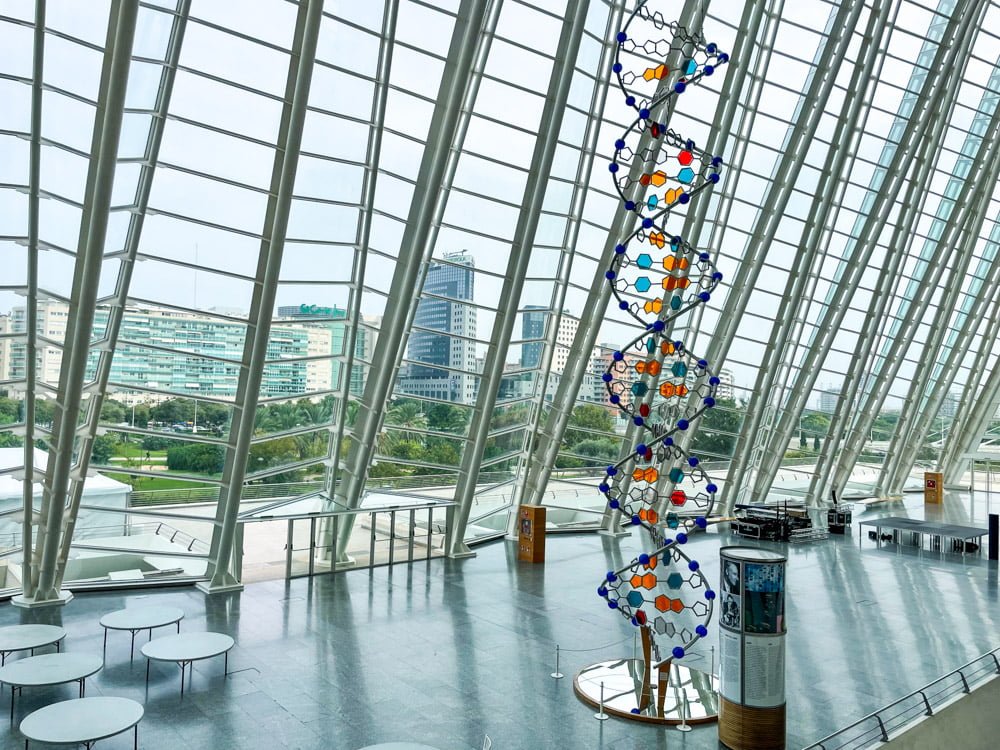
You may have already heard of the Science Museum Principe Felipe in Valencia for its enlarged reproduction of the DNA molecule and its Foucault pendulum, one of the largest in the world, measuring 30 metres in length. Still, this is only one of the fantastic things to discover inside the museum.
The Valencia Science Museum’s layout introduces all aspects of science and technology interactively, with a dedicated area for younger children.
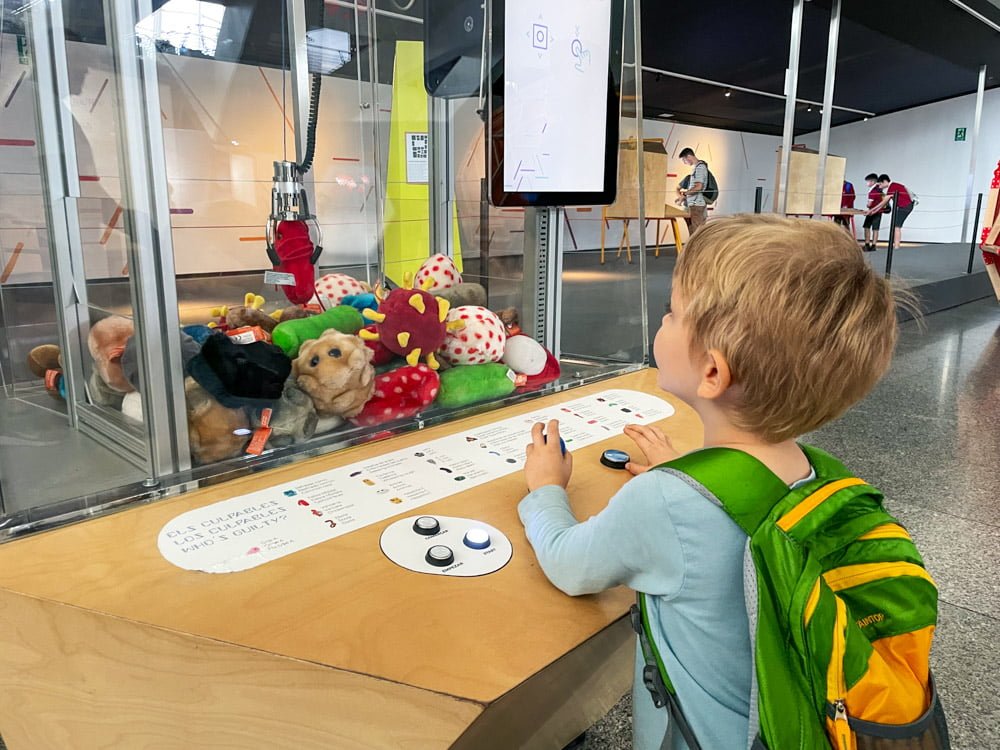
Valencia Science Museum: what’s on
The Valencia Science Museum is a massive facility spreading across 42,000 square metres on four floors. Each floor is dedicated to a different topic, such as biology, science, or technology. From the birth of chicks to living modules for space exploration, the museum covers it all!
I recommend studying the museum sections in advance to decide which area you’d like to explore more and make the most of your visit. Don’t worry if you need to leave for lunch, as you can return by showing your ticket at the entrance gate.
The Valencia Science Museum features permanent and temporary exhibitions related to contemporary society. During my visit, I experienced the fantastic Viral exhibition about the spread of contagious diseases like COVID-19, as well as financial collapses and global events.
All the museum exhibitions are designed for interactive enjoyment, making them perfect for families. While adults can appreciate the futuristic architecture and scientific insights, children can have a great time discovering how the world around them works.
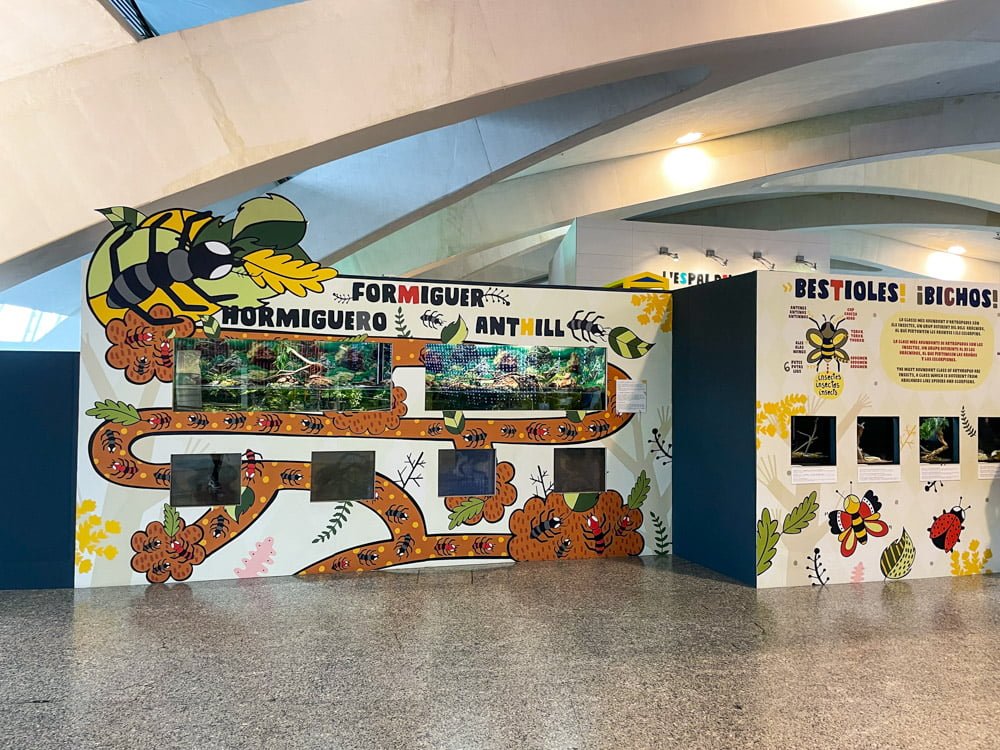
Ground floor: dining areas, shops and installations
Science Museum Principe Felipe’s ground floor hosts the ticket office, a restaurant, a cafeteria, an auditorium and a souvenir shop. Still, there are also interactive exhibitions that give you a glimpse of the museum.
You can access the ground floor for free. I recommend having breakfast at the cafeteria if you arrive early, as coffee and pastries are excellent.
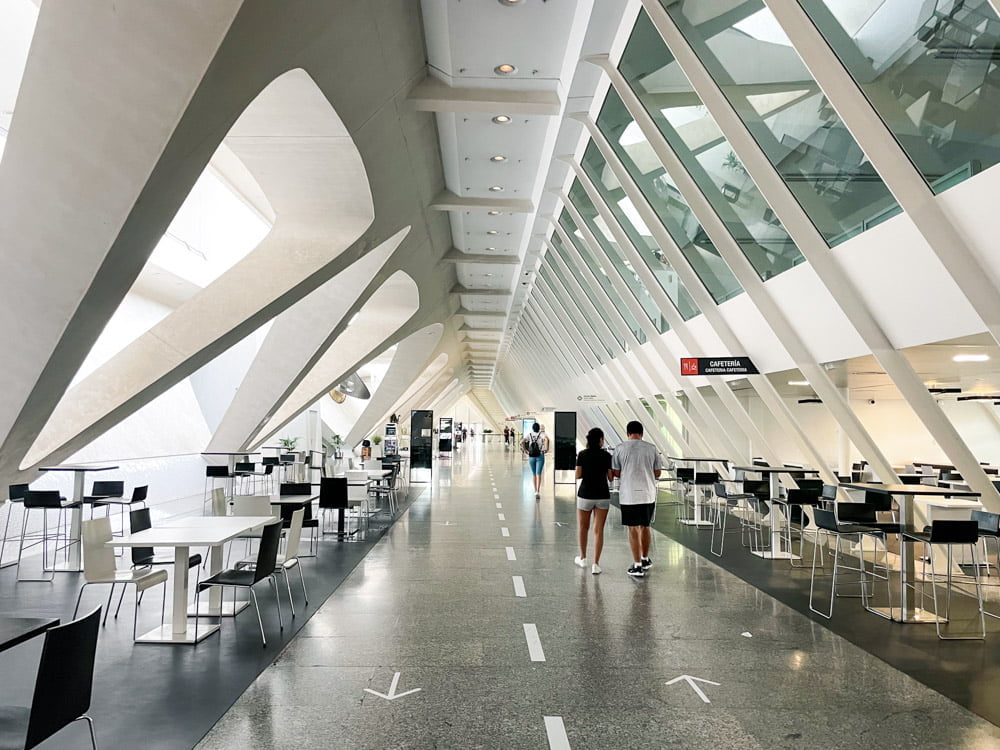
First floor: children’s space, animals and exhibitions
The first floor of the Valencia Science Museum is the most interesting for young visitors. It starts with insects, including ants in their ant-hills visible behind glass and the curious stick insects that look like sticks. In particular, you can see the same species only in a few places in Europe, like the Biosphere in Genoa in Italy, as they are pretty rare.
Next to them are incubators with chicks’ eggs where you can watch them hatch, from the breaking of the shell to the first moments of life. For the children, it is a wonderful experience. Also, for us adults, it is a unique emotion to see eggs hatching right in front of our eyes.

The first floor also hosts the Espai dels Xiquets, a space for children aged 3 to 8 years old. Here, there are animals to see and a play area where kids can build a brick house with other children to develop collaboration and cooperation. My son enjoyed operating a winch and moving bricks with a wheelbarrow.

Temporary exhibitions
On the first floor of the Valencia Science Museum, some temporary exhibitions are always worth visiting. During my trip to Valencia, there were two exhibitions. ‘Viral. Una experiencia contagiosa’ explained how yawns, laughter, and economic disasters could be contagious like diseases.
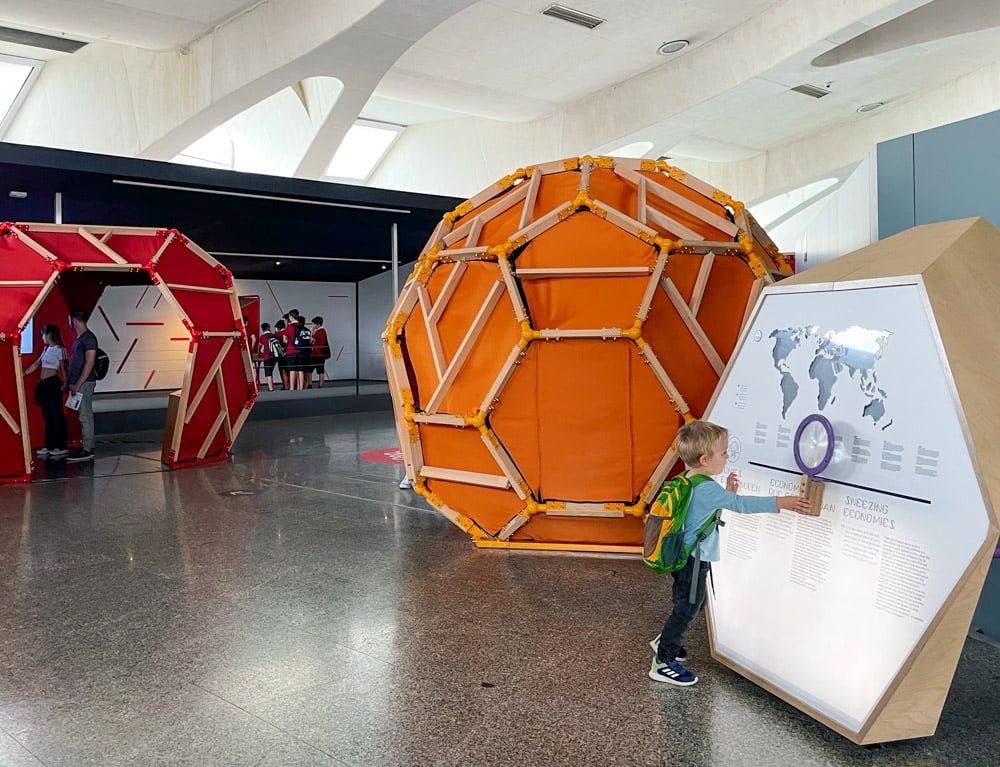
‘Play. Ciencia y Música’ was about the physics of sounds and vibrations, and how they influence our reactions. Here, my son found his passion for drumming. At the same time, I enjoyed playing a real theremin, previously seen only at the Museum of Musical Instruments in Brussels. The first floor also hosts two permanent attractions of the Valencia Science Museum: the enormous Foucault pendulum and the giant DNA sculpture.
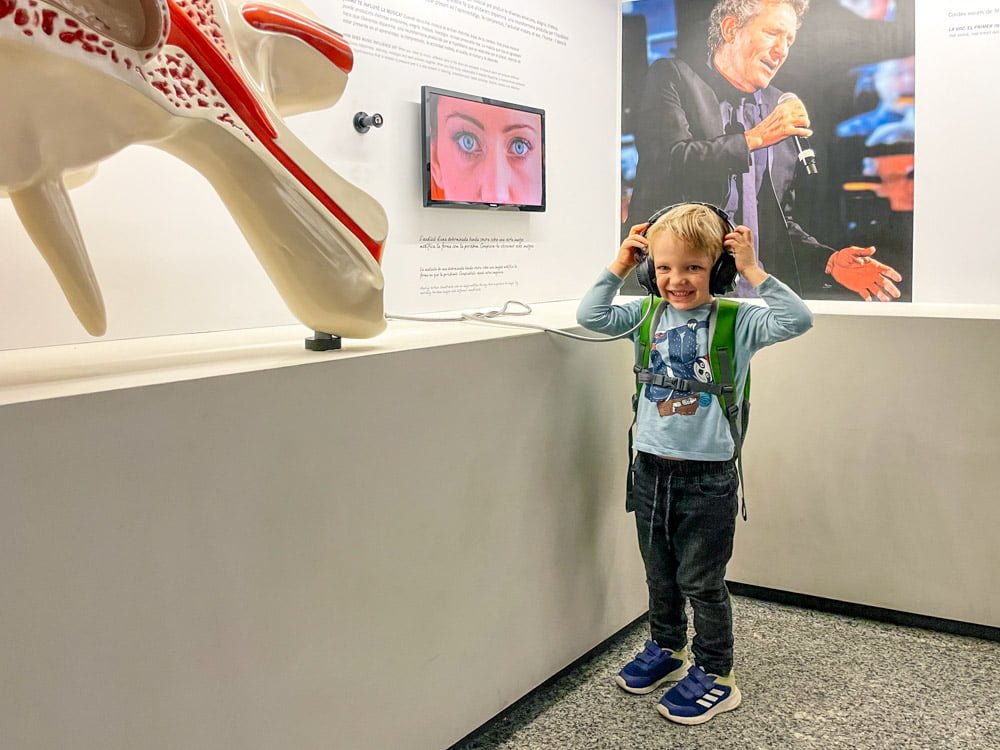
Second floor: Spanish scientists who made history
The second floor houses the exhibition ‘El llegat de la Ciència’, the Legacy of Science, dedicated to the lives and discoveries of Spanish scientists Severo Ochoa, Ramón y Cajal, Jean Dausset and Santiago Grisolía. Unfortunately, at the time of my visit, the captions of this permanent exhibition were only in Castilian and Catalan, not English. If you do not speak these languages, it isn’t easy to understand the international importance of these scientists.
Ramón y Cajal won the Nobel Prize in Medicine in 1906 for his work on the nervous system’s structure. On the other hand, Severo Ochoa won the Nobel Prize in Physiology and Medicine in 1959 for his discovery of the biological synthesis mechanisms of DNA and RNA.
The last winner of the Nobel Prize in Physiology and Medicine recounted in this plan is Jean Dausset in 1980. With scientists Baruch Benacerraf and George D. Sneill, he discovered the HLA system to determine the rejection in organ transplants. Finally, the Valencian scientist Santiago Grisolía, a pupil of Severo Ochoa, is also remembered.
Third floor: conquering space
We were most intrigued by the third floor of the museum. The temporary exhibition ‘Mars: La conquista de un sueño’ was fascinating. It delved into space exploration and the possibility of living on Mars, with rovers, space base plans, and explanations of how human physiology changes in space.
The exhibition was beautiful, with interactive installations that enchanted us. We even dreamed of living on Mars in one of the incredible modules designed for these explorations.
The third floor also features a space simulator to book separately. Unfortunately, we did not try it because it is only accessible to those with a minimum height of 1.10 metres, and my son was shorter at the time of our visit.
Also, there is the Chromosome Forest, a path dedicated to DNA discovery. Visitors can explore the 23 pairs of chromosomes present in human cells through interactive games.

The Valencia Science Museum with children
The Museu de les Ciències Príncipe Felipe is a must-visit place in Valencia, especially for families with children. It offers a variety of activities suitable for both young kids and teenagers.
During our trip to Valencia, my four-year-old son enjoyed exploring the Espai dels Xiquets, specially designed for young children, and the sound and space exploration areas. Following your children’s interests is essential when choosing which exhibitions to see.
If you plan to visit all the museum areas, take a lunch break and return in the afternoon. On a sunny day, you can picnic in the beautiful Jardin del Turia before continuing your visit.
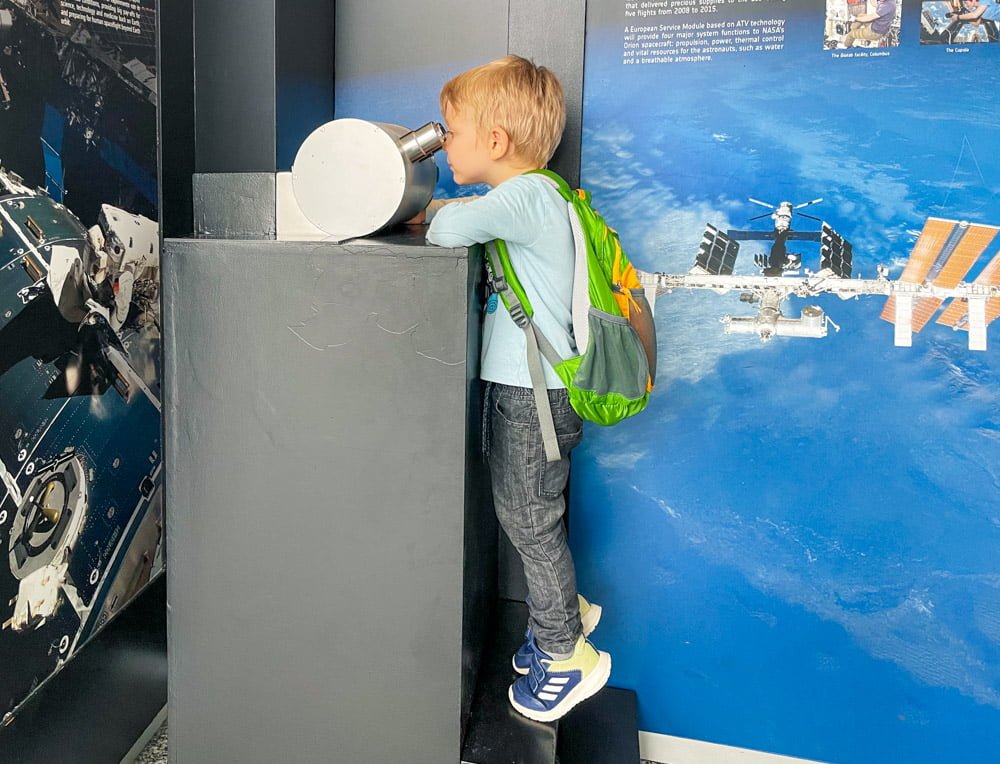
Practical information for visiting the Valencia Science Museum
The Science Museum Principe Felipe has a variety of exhibitions that change frequently, so I suggest you return whenever you’re in Valencia. Although you might find different exhibits on your next visit, something else will be interesting.
If you want to explore the museum fully, plan to spend at least half a day there. It’s a large museum, so taking a break for lunch and returning afterwards is a good option if you have more time. The museum is open every day from 10:00 am to 6:00 pm. On some holidays, it stays open until 9:00 pm.
To experience the space simulator, which costs €2.50, you must book it at the museum ticket office. Children under 12 must be at least 1.10 m tall and accompanied by an adult. Since it’s a popular attraction, I recommend booking it when you arrive.
On the museum’s ground floor, there is a gift shop that sells books, T-shirts, and soft toys. However, if you’re looking for gifts, most books are in Spanish, and there are just a few in English or other European languages.
Where to buy tickets for the Science Museum Principe Felipe
You can buy tickets for the Valencia Science Museum directly at the ticket office. However, I recommend buying your tickets online to ensure you get in on busy days such as weekends and school holidays.
How to get to the Valencia Science Museum
The Prince Felipe Science Museum is in the heart of the beautiful Jardin del Turia park. You can get there by public transport, on foot, or by bicycle, depending on your accommodation. Check Google Maps for the best route from where you are. I don’t recommend getting here by metro unless you want to go for a walk, as the stop is quite far from the entrance.
Museu de les Ciències Príncipe Felipe (Science Museum Principe Felipe)
Ciudad de las Artes y de las Ciencias
Avenue del Professor López Piñero, 7
46013 Valencia
Where to stay in Valencia
Valencia offers a variety of accommodation options, including hotels, pensions, and flats. If you’re looking for a luxurious stay, MYR Palacio Vallier Hotel has a terrace, restaurant, and bar. BONNIES Suites & Spa Valencia offers apartments near Valencia Central Market with a kitchen and shared spa. Helen Berger Boutique Hotel is a lovely boutique hotel with breakfast and is near the Turia Gardens.
The Science Museum in Valencia is wonderful. I had a great time with my son discovering new scientific and technological curiosities. Feel free to comment if you already know the Museu de les Ciències Príncipe Felipe or if I have intrigued you with this post.
